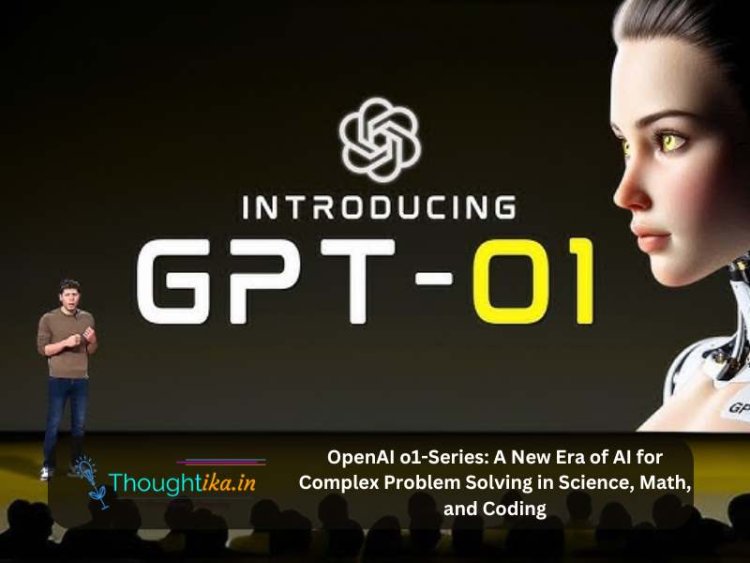OpenAI o1-Series: A New Era of AI for Complex Problem Solving in Science, Math, and Coding
Discover the OpenAI o1-series, a groundbreaking AI model for complex problem-solving in science, math, and coding. Learn how this new series enhances AI reasoning, safety, and developer workflows.

OpenAI o1-Series: A Game-Changer for Complex Problem Solving in Science, Math, and Coding
Artificial intelligence continues to evolve, and OpenAI is once again at the forefront with the introduction of the OpenAI o1-series. This new set of AI models is designed specifically to handle complex problems, outperforming earlier models in areas such as science, math, and coding. Whether you're a researcher, developer, or student, the OpenAI o1-preview and its o1-mini counterpart are tailored to provide more accurate reasoning and enhanced problem-solving capabilities.
In this article, we’ll explore what the OpenAI o1-series offers, who can benefit from it, and how it stands apart from previous AI models.
What is the OpenAI o1-Series?
The OpenAI o1-series represents a significant leap in AI reasoning capabilities. Unlike previous models like GPT-4, which was known for its wide-ranging knowledge and versatility, the o1 models are trained to spend more time thinking through problems. This approach allows the AI to refine its problem-solving process, explore different strategies, and recognize mistakes more effectively.
Why is OpenAI o1 Important?
The o1-series models are more advanced in handling complex tasks that require deep reasoning. This new AI architecture is particularly useful for professionals and researchers in fields that demand a more analytical approach, such as:
- Healthcare: Annotating cell sequencing data.
- Physics: Creating intricate mathematical formulas for quantum optics.
- Developers: Building and executing multi-step coding workflows, making this model invaluable for software development and debugging.
In fact, the next iteration of this model has been tested against challenging benchmarks, performing on par with PhD students in subjects like physics, chemistry, and biology. Its performance in coding is also impressive, with an 89th percentile ranking in Codeforces competitions.
Enhanced Problem Solving and Safety in the o1-Series
The most notable difference between the OpenAI o1-series and earlier models is its ability to reason through safety rules. OpenAI has implemented a more sophisticated training method that makes these models better at adhering to safety guidelines. This is crucial in ensuring that the AI cannot be easily manipulated or "jailbroken."
On one of OpenAI’s most rigorous jailbreaking tests, the GPT-4 model scored 22 on a 0-100 scale, while the o1-preview achieved an impressive score of 84. This makes the o1-series much safer and more reliable for both individual users and larger organizations that need to maintain compliance with strict safety standards.
In addition, OpenAI has expanded its collaboration with the U.S. and U.K. AI Safety Institutes, giving these organizations early access to research models for further evaluation and testing. This partnership aims to develop and improve AI safety protocols that can be applied globally.
OpenAI o1-mini: A Cost-Effective Solution for Developers
Alongside the o1-preview, OpenAI has introduced a smaller and more affordable model, the o1-mini. While it’s smaller in scale, the o1-mini is incredibly effective for coding tasks, offering 80% of the capabilities of the o1-preview at a fraction of the cost. This makes it an excellent choice for developers who need robust problem-solving abilities but don't require the full range of capabilities offered by the o1-preview.
How to Access the OpenAI o1-Series
If you're a ChatGPT Plus or Team user, you can start using both the o1-preview and o1-mini models right away. The rate limit is set at 30 messages per week for o1-preview and 50 messages per week for o1-mini. OpenAI also plans to make o1-mini available to ChatGPT Free users in the near future.
For developers, the models are accessible through the OpenAI API, but there are rate limits of 20 RPM (requests per minute) during the early access phase. These limits are expected to increase as OpenAI continues to test and improve the models.
Conclusion
The OpenAI o1-series is a major step forward in AI-driven problem-solving. By focusing on deep reasoning, these models are designed to tackle the most challenging tasks in fields like science, coding, and math. With a focus on both accuracy and safety, the o1-series provides a new level of capability that is set to revolutionize the way professionals and researchers approach their work.
For those looking for more cost-effective solutions, the o1-mini offers a lightweight, affordable model that’s perfect for developers. Whether you're involved in cutting-edge research or day-to-day coding tasks, the OpenAI o1-series is a tool that can significantly enhance your workflow.
Reference
What's Your Reaction?
















